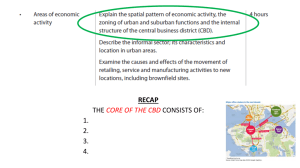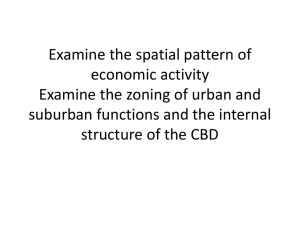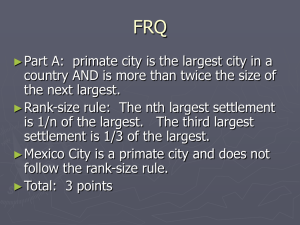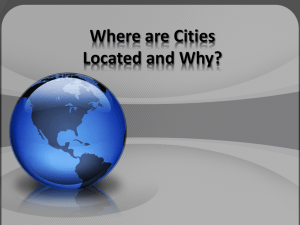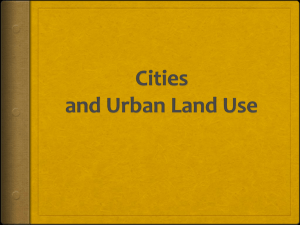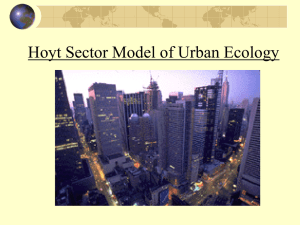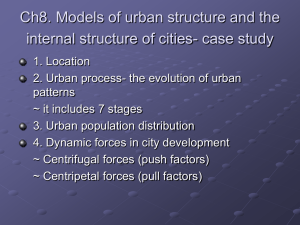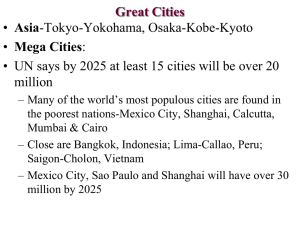2. Which of the following countries is least urbanized? # of people
advertisement
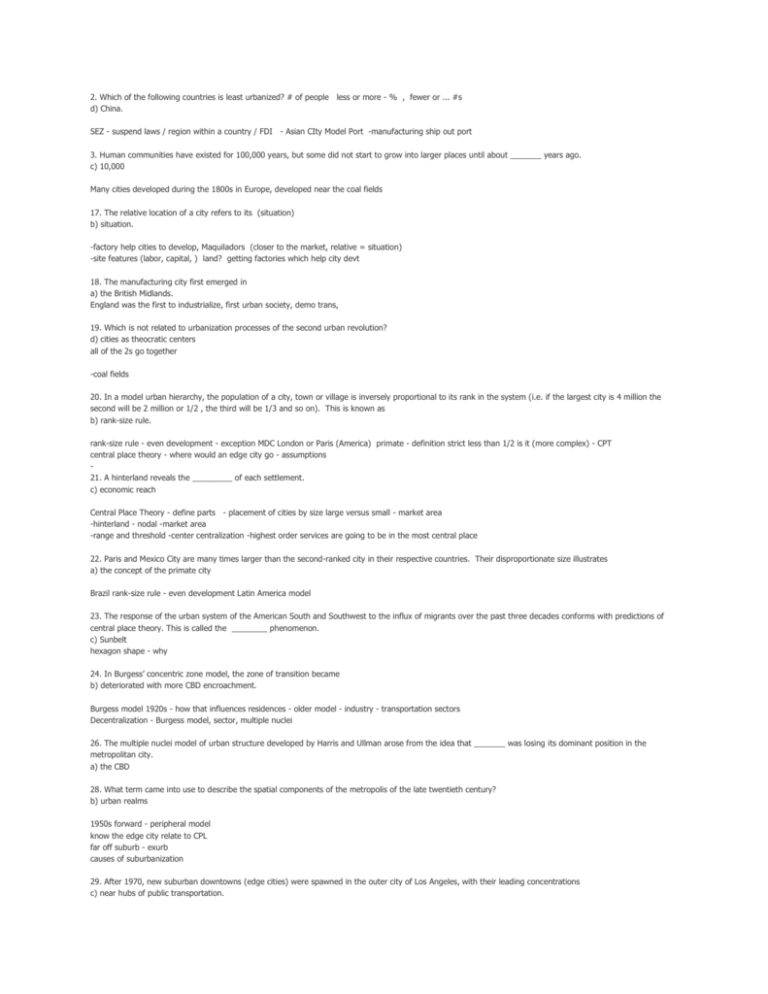
2. Which of the following countries is least urbanized? # of people less or more - % , fewer or ... #s d) China. SEZ - suspend laws / region within a country / FDI - Asian CIty Model Port -manufacturing ship out port 3. Human communities have existed for 100,000 years, but some did not start to grow into larger places until about _______ years ago. c) 10,000 Many cities developed during the 1800s in Europe, developed near the coal fields 17. The relative location of a city refers to its (situation) b) situation. -factory help cities to develop, Maquiladors (closer to the market, relative = situation) -site features (labor, capital, ) land? getting factories which help city devt 18. The manufacturing city first emerged in a) the British Midlands. England was the first to industrialize, first urban society, demo trans, 19. Which is not related to urbanization processes of the second urban revolution? d) cities as theocratic centers all of the 2s go together -coal fields 20. In a model urban hierarchy, the population of a city, town or village is inversely proportional to its rank in the system (i.e. if the largest city is 4 million the second will be 2 million or 1/2 , the third will be 1/3 and so on). This is known as b) rank-size rule. rank-size rule - even development - exception MDC London or Paris (America) primate - definition strict less than 1/2 is it (more complex) - CPT central place theory - where would an edge city go - assumptions 21. A hinterland reveals the _________ of each settlement. c) economic reach Central Place Theory - define parts - placement of cities by size large versus small - market area -hinterland - nodal -market area -range and threshold -center centralization -highest order services are going to be in the most central place 22. Paris and Mexico City are many times larger than the second-ranked city in their respective countries. Their disproportionate size illustrates a) the concept of the primate city Brazil rank-size rule - even development Latin America model 23. The response of the urban system of the American South and Southwest to the influx of migrants over the past three decades conforms with predictions of central place theory. This is called the ________ phenomenon. c) Sunbelt hexagon shape - why 24. In Burgess’ concentric zone model, the zone of transition became b) deteriorated with more CBD encroachment. Burgess model 1920s - how that influences residences - older model - industry - transportation sectors Decentralization - Burgess model, sector, multiple nuclei 26. The multiple nuclei model of urban structure developed by Harris and Ullman arose from the idea that _______ was losing its dominant position in the metropolitan city. a) the CBD 28. What term came into use to describe the spatial components of the metropolis of the late twentieth century? b) urban realms 1950s forward - peripheral model know the edge city relate to CPL far off suburb - exurb causes of suburbanization 29. After 1970, new suburban downtowns (edge cities) were spawned in the outer city of Los Angeles, with their leading concentrations c) near hubs of public transportation. 30. Mexico City and Sao Paolo are best used as examples of c) mega cities 32. In the Latin American city, where are the homes of the most impoverished and unskilled residents? c) on the outermost zone or peripheral fringe 33. A structural element of many Latin American cities, the disamenity sector, is illustrated by the b) barrios or favelas. 34. Which of the following is both the least urbanized and the most rapidly urbanizing realm of the world? a) Middle Americab) Africa south of the Saharac) East Asiad) South Asia African city model - ask you what is not there -3rd sector jobs and middle and wealthy 36. The focal point of the Southeast Asian city is the a) old colonial port zone 35. Most African central cities actually have how many CBD’s? c) three 38. Comparing Luanda, Angola to a suburb of Tokyo one is struck by the fact that the urban morphology reflects the fact that Angola lacks a __________ class. b) middle 40. If cities in the poorer parts of the world share a common characteristic, it may result from a) an absence of enforced zoning regulations. 41. Segregation in the United States was reinforced by the financial practice known as a) redlining. blockbusting, filtering redlining zoning - modern suburbs - income level - property taxes -zoning house size 42. In core area cities the practice of buying up and rehabilitating deteriorating housing which resulted in the raising of housing values and a social change in neighborhoods is called b) gentrification. 44. The decline in density and the spread of cities associated with the building of freeways in the second half of the twentieth century has been pejoratively referred to as b) urban sprawl. 1st and second urban revolutions suburbs -high property taxes and zoning 2 As a result of high land costs, the American CBD is characterized by B construction of skyscrapers Burgess - business center, retail stores, factories Descriptions of the job sectors and then the services found in cities in differing parts of the world at differing times 5. the process of legally adding land area to a city in the U.S. is C annexation 6. A process by which real estate agents convince white owners to sell their homes is A blockbusting 7. The most significant benefit of the enclosure movement was to B promote agricultural efficiency 8. To deal with the financial problems in some areas of the city, American governments B reduce services Inner City Issues Gentrification 9. British cities are surrounded by open spaces known as A greenbelts 10. A legal form of segregation in U.S. cities is achieved through C zoning central place - define it and know that it beleives the center offers the most services. 11. The U.S. government has encouraged the use of cars in part by -growth of the suburbs A building interstate ighways 12. According to the concentric zone model a city develops in a series of B rings know what 1st, second and 3rd sector jobs are and which cities have them (definitions may be the answers for city questions) 14. Higher income people tend to live near the center of the city in all but which of the following regions B north america Usually the modern city theories have decentralization of the CBD as a part of it - exception new urbanism 17The minimum number of people needed to support a service is E central place 18Larger settlements are C less numerous and less together 19Whys is the absence of a rank-size distribution significant in a country like Romania Aconsumers do not have access to goods Bthe capital is a primate city Cconsumers do not have to travel far for goods or services Dconsumers are less likely to take buses to obtain goods and services Eboth b and d 20All of the following are true about central place theory except E NONE 21According to the sector model, the best housing is located in A Corridor from the downtown to the edge of the city -away from industry -geographic feature (high land, lake) 22The CBD attracts offices primarily because of its A High accessibility 23In the U.S. which of the following definitions of a city covers the largest land area D Metro Statistical Areaa 25A land use typically excluded from a North American CBD is B Industrial 26Megalopolis refers to AAdjacent overlapping Metropolitan Statistical AreasBCentral Cities CCBD plus outer suburbsDCentral cities plus urbanized areas EConsolidated Metro Stat Areas 27Public transportation is better suited for commuting to the CBD primarily because A It is less expensive C Commuters desire to use it E Both a and c 31Rural settlements differs from urban settlements primarily according to which type of activity B economic 34A process by which banks designate an area within which they refuse to lend money for improvements ABlockbustingBFilteringCGentrification DRedliningEUrban renewal 35Producer services provide what kind of services ADiffusion and distribution of services BServices to businesses CServices for the wellbeing of individuals DSecurity and protection EBoth a and b -could add found in LDC, MDC city core or periphery and city model 36The area surrounding a service from which customers are attracted is the AHinterland Brange Cthreshold Dmedian Ecentral place theory 38U.S. central cities face fiscal problems because B Low-income people are concentrated here 39A recent change in the density gradient has been AThe elimination of the gap traditionally found in the center BAn increase in the extremes between the inner and outer areas CAn increase in the number of people living in the center DA reduction in the differences in densities found within an urban area EAn increase in the differences in densities found within an urban area 40According to the gravity model, the potential use of a service at a location is related C Directly to population and inversely to distance 44In recent years, urban metro areas residents are more likely to shop in ACorner shops BDowntown stores CSuburban malls DAll of the above 45A market area is a good example of what kind of region C functional 46Which city model most reflects the influence of cars of cars? mutiple nuclei pedestrian versus car scale 47Which model modified the concentric zone model to take into account transportation routes sector 48How does the pattern of buildings change as you reach the center of a city it changes according to the bid-rent pattern and goes from low intensity to high intensity land use in the CBD 49What is at the center of the concentric zone model and many other city models CBD 50According to the sector model where would the lower class neighborhoods exist (next to what) industry middle class all along a spine from the CBD all next to the CBD none of the above 51In what year will the majority of people be living in cities? 2030 Many peope in periphery country cities are recent migrants to the city are equal in regards to having sh 52In what type of country do you find most of the world's urban population? MDCs 53What is the biggest difference in the type of buildings that create sprawl versus the type of buildings you find downtown? horizontal and mixed use zones vertical and mixed use zones closely clustered low intensity land use downtown closely clustered horizontal buildings in the sprawl all of the above 54What is the main idea behind the design of urban sprawl to build malls and use single use zonign to separate areas of usage 55In the Latin American model, where do the rich live all along a spine from the CBD 56What is the difference between the edge of Latin American cities and zone of accretion building material buildings take delivery of resources like water and gas buildings in the zone of accretion are more temporary and made of scrap metals closer into the city the buildings are more permanent both a and c all of the above 2. Which of the following countries is least urbanized? d) China 1. The layout of a city, the physical form and structure, is referred to as a) urban morphology 5. Where did the first urban development originate? d) Western Europe 7. Ancient towns and cites owed much of their success and growth to certain site advantages. Which of the following was not one of these advantages? a) proximity to productive farmlandsb) good supplies of coal and ironc) availability of water supplies d) good defensibility 17. The relative location of a city refers to its b) situation. 20. In a model urban hierarchy, the population of a city, town or village is inversely proportional to its rank in the system (i.e. if the largest city is 4 million the second will be 2 million or 1/2 , the third will be 1/3 and so on). This is known as b) rank-size rule. 21. A hinterland reveals the _________ of each settlement. a) total populationb) working populationc) economic reach d) aggregate purchasing power 26. The multiple nuclei model of urban structure developed by Harris and Ullman arose from the idea that _______ was losing its dominant position in the metropolitan city. a) the CBD 29. After 1970, new suburban downtowns (edge cities) were spawned in the outer city of Los Angeles, with their leading concentrations c) near hubs of public transportation. 31. In Latin America, which of the following does not accurately describe the typical CBD? a) the primary business focus b) principal entertainment center c) main area of employment d) an area of out-migration to suburbs 32. In the Latin American city, where are the homes of the most impoverished and unskilled residents? c) on the outermost zone or peripheral fringe 33. A structural element of many Latin American cities, the disamenity sector, is illustrated by the b) barrios or favelas. 34. Which of the following is both the least urbanized and the most rapidly urbanizing realm of the world? a) Middle Americab) Africa south of the Saharac) East Asiad) South Asia 36. The focal point of the Southeast Asian city is the a) old colonial port zone. 37. In Southeast Asian cities the alien commercial zone is dominated by c) Chinese. 47. Ethnic neighborhoods in European cities reflect migrants from a) Eastern Europe.b) poor Mediterranean Europe.c) former colonies.d) Latin America. 6. The large percentage of population involved in agriculture in China indicates that E. most people must produce food for their own survival. 16. Eastern North America is the continent's manufacturing center in part because it has access to the continent's A . largest markets 17. Situation costs are critical to a firm that wishes to A. avoid labor unions. B. minimize production costs inside the plant. C. minimize transport costs. D. identify unique characteristics of a particular location. E. increase bulk-reducing industries 18. The location of a maquiladora plant is a good example of the importance of A. product size determining a location B. labor costs and government restrictions determining a location C. Post-Fordist production. D. break-of-bulk points. E. both a and b -will make this relate to future development of cities in Mexico 21. A manufacturer of women's and children's underwear is more likely than Google to A. relocate in a developing country B. go out of business C. need more capital. D. all of the above Southern cities / states still are close to the market but have lower costs due to right to work laws, less restrictions and lower taxes, etc (also post-fordism) 24. Transnational corporations have transferred some work to less developed countries because of access to B. labor. 25. In contrast to fordist production, Post-Fordist production is more likely to E. introduce more flexible work rules. 26. Maquiladoras are possible because of the change in what type of function of our border? A. operational B locational C situational D linguistic E Girastic 27. What two features best characterize the changes affected by the Industrial Revolution? A. service industries and information processing B. technological innovation and specialization C. improved farm implements and the development of hybrid seeds D. higher literacy rates and decreased population doubling time E. well-equipped professional armies and the deployment of nuclear weapons 28. Which of these statements about core-periphery relationships is correct in characterizing the global economic system? A. It works to the advantage of periphery countries B. It works to the disadvantage of core countries C. It works to the advantage of both core and periphery countries D. It works to the disadvantage of periphery countries E. It is irrelevant in a complex worldwide economic system 29. An industry is said to be footloose if A. transport costs have little bearing on location B. transport costs determine location C. power costs determine location D. borders of a country do make a difference in its location E. labor costs determine location 30. Which of the following is not typically defined as one of the four key determinants of development? A. Per capita GDP B. Literacy rate C. physical environment D. Life expectancy E. Amount of education =cbr verus cdr 31. Purchasing power parity refers to B. a monetary measurement that takes into account what money actually buys 32. People are more productive in more developed countries because they B. have access to more technology. 33. The lifespan of women and their survival rate from birth would be relevant to which A. The Gender-Related Development Index 34. Assumptions in Rostow’s development model include all of the following except A. the world is the same as when MDCs moved through the model B. every country will move from step 1 through step 5 C. LDCs do not face additional barriers due to a crowded field D. development somewhere requires underdevelopment somewhere else E. both B and D 35. A transnational corporation A. operates in countries other than the one in which its headquarters are established B. has the potential to be more economically powerful than a sovereign state C. takes advantage of global production networks D. allows corporations to take advantage of the full range of geographical variations in costs E. all of the above 36. A copper concentration mill tends to locate near a copper mine because it is a A. bulk-reducing industry. B. perishable industry. C. site factor. D. specialized manufacturer. E. capital issue 37. Since 1980, new U.S. automobile assembly plants have been built in the A. Midwest, to minimize national distribution costs. B. Northeast, to minimize access to the largest market. C. Sunbelt, to minimize labor costs. D. West, to minimize access to Japan. E. Southeast, where labor is cheap 38. Industrial areas outside North America and Europe have become increasingly important in recent years primarily because of A. access to markets. B. access to raw materials. C. break-of-bulk points. D. site factors. E. situation factors 39. All of the following are examples of perishable products except A. daily newspaper B. milk C. steel D. all of the above are perishable products E. both A and B 42. The most significant benefit of EPZs for LDCs is A. the influx of foreign-owned businesses B. improved jobs skills for workers C. creation of employment opportunities D. money made from tariffs E. high wages 43. Which of the following are negative aspects of EPZs? A. Components are not locally purchased B. LDC must provide infrastructure C. Concessions often outweigh benefits D. Low wage jobs E. All of the above 19Whys is the absence of a rank-size distribution significant in a country like Romania Aconsumers do not have access to goods 57 minutes ago · Like Dawid Zawiślak 26Megalopolis refers to AAdjacent overlapping Metropolitan Statistical Areas 56 minutes ago · Like Dawid Zawiślak 34A process by which banks designate an area within which they refuse to lend money for improvements DRedlining 36The area surrounding a service from which customers are attracted is the AHinterland 39A recent change in the density gradient has been DA reduction in the differences in densities found within an urban area 7. Ancient towns and cites owed much of their success and growth to certain site advantages. Which of the following was not one of these advantages? b) good supplies of coal and iron 21. A hinterland reveals the _________ of each settlement. c) economic reach 31. In Latin America, which of the following does not accurately describe the typical CBD? c) main area of employment 34. Which of the following is both the least urbanized and the most rapidly urbanizing realm of the world? b) Africa south of the Sahara (not sure) 51 minutes ago · Like
